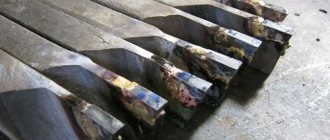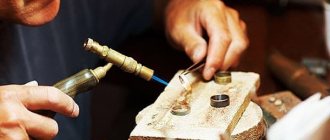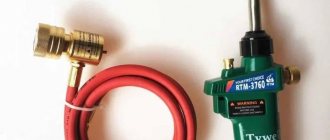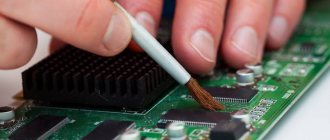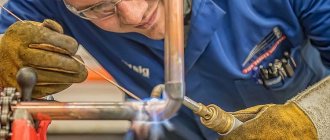High-quality soldering of cutters at home
Everyone who is engaged in turning is faced with such a problem as soldering cutters at home. This is a rather necessary procedure, which solders carbide plates onto the holders of turning tools and helps to harden the tool. This involves a high-frequency current or a gas burner. But for the latest equipment you still need to have good experience.
How to solve the problem without specialized equipment?
Previously, the method of heating the cutters using a contact machine was used. It has been used perfectly at home. Soldering occurred through the thermal effect of electric current on the conductor. To control the heat generated, you simply need to adjust the amount of electric current, the resistance of the conductor and watch over time how long it will act on the conductor.
Focusing on these three factors, a unit was developed that is a step-down transformer. It has a primary and secondary winding. The first is calculated at 220 V, and the second at 2 V. The diameter of the transverse magnetic wire is 50 sq. cm. The transformer itself is mounted on the base, while the contact bars are located on the insulating gasket.
The base of the transformer, which has legs, is made of sheet steel 5 cm thick. Also in this design there are two windows that act as ventilation.
The ends of the secondary winding have their own clamp holes. The entire structure of the device is protected by a special casing, which is attached to the base of the transformer using corners. One of these fasteners has an insulating block.
Differences and features of soldering types
The cutters can be connected by low- or high-temperature soldering. But if judged objectively, then their physical nature does not have any special differences.
The two metals are joined together by a third metal, which is called solder. The connecting metal has a melting point lower than the elements being connected.
But depending on which soldering you choose, the characteristics of the resulting product will also depend.
As the names suggest, one of the differences is the melting point. But that is not all.
- First of all, the use of hard solders guarantees a better and more reliable connection of parts, unlike soft ones.
- High-temperature soldering also has stronger thermal stability of the connections. The solder used for this work has a high melting point, so it can withstand higher temperature loads without losing its properties. But there is also a nuance here, in such soldering, which is inferior to low-temperature soldering. In the first case, under the influence of high levels, structural changes in some metals may occur. For example, a cast iron connection becomes quite fragile.
- When using high-temperature soldering, you have to select the appropriate tools. For such a procedure it is necessary to reach a temperature of 1000 degrees. That is, the soldering iron is no longer suitable for such a process.
If we combine all of the above, it turns out that high-temperature soldering provides strength and thermal stability of the connection, but at the same time requires more highly qualified equipment and the ability to perform soldering that is quite complex in technology. While low-temperature soldering has more simplified requirements, the quality of the resulting parts is somewhat lower.
Brazing
The use of hard solders occupies an intermediate position between low-temperature soldering and welding.
They are used in cases where the strength of the resulting joints and the integrity of the metal structure become important. In this process, carbide plates are often used, which, when connected, do not spoil the original geometry of the structure.
This technology is used for repairing refrigeration or heat exchange systems, steel or copper pipelines, etc. It is also used in automotive repair to repair radiators, engines, transmissions, bodies and other similar parts.
If there is a need to repair products that are susceptible to high temperatures during operation (for example, a wood-burning samovar), then high-temperature soldering is simply necessary.
As for the equipment, in this case, a technique is required that is capable of providing a temperature higher than that required for melting the parts being connected. The average range can vary from 450 to 1200 degrees, provided that the entire procedure is performed at home. Gas burners, inductors and furnaces have such indicators.
Types of solders used
Copper can also be used to solder the cutter, although alternatively it can be used with other metals (zinc, silver, silicon, tin, etc.). Each of these components reduces the melting point.
But it should be noted that such solders are not recommended for use if the work is to be done with steel or cast iron, since in this case phosphites are formed, which affect the strength of the connection. Such a seam will be very fragile, and if vibration or bending pressure is applied, the connection may deform or simply burst.
How to solder cutters yourself?
In order to perform soldering, you must follow the following steps:
- First of all, it is necessary to clean all metal elements. The oxide film is removed.
- The cutter holder is installed on the transformer busbars. The area that will be solderable must be pre-treated with flux. After this, the solder begins to work.
- Using tweezers, solder is inserted between the edges that require joining. In a particular case, it is better to use a sheet of brass for this purpose.
- During operation of the unit, the contact area will heat up. This contributes to the melting of the metal, and as soon as this process is completed, the contact will disintegrate, and, accordingly, the process will stop. Therefore, in order for soldering to be continuous, all work is carried out in pulse mode, while the load on the windings must be applied gradually.
The heating itself is carried out over the entire surface, moving smoothly from side to side. The solder should acquire a color from dark cherry to light cherry, which will indicate heating to the required temperature.
While visually monitoring the entire process, it is necessary to carefully apply all the solder. You should know that the holder heats up at a rate of 80-100 degrees per second. Using this method for connecting cutters, you can be sure of obtaining excellent quality.
If the flux has been applied in sufficient quantity, the solder will spread easily. After completion of the work, the seams are cleaned.
It is believed that a high-grade connection is one that does not exceed 0.1 mm. As is clear, there is nothing complicated in home soldering. The main thing is to have all the necessary tools and materials at hand. But you need to remember that during the entire process you should follow personal safety rules, since high temperatures can harm the solder.
How to solve the problem without specialized equipment?
Previously, the method of heating the cutters using a contact machine was used. It has been used perfectly at home. Soldering occurred through the thermal effect of electric current on the conductor. To control the heat generated, you simply need to adjust the amount of electric current, the resistance of the conductor and watch over time how long it will act on the conductor.
Focusing on these three factors, a unit was developed that is a step-down transformer. It has a primary and secondary winding. The first is calculated at 220 V, and the second at 2 V. The diameter of the transverse magnetic wire is 50 sq. cm. The transformer itself is mounted on the base, while the contact bars are located on the insulating gasket.
Design of a welding inverter.
The base of the transformer, which has legs, is made of sheet steel 5 cm thick. Also in this design there are two windows that act as ventilation.
The ends of the secondary winding have their own clamp holes. The entire structure of the device is protected by a special casing, which is attached to the base of the transformer using corners. One of these fasteners has an insulating block.
Solder for soldering cutters
The warranty period for ELSIT LLC equipment is 24 months
High-frequency soldering: Which solders and for which materials are more suitable
High-frequency soldering is carried out due to the fact that the molten solder spreads in the gap between the parts of the part that need to be connected. It should wet the soldered materials well and also spread easily over the surface of the product.
Solders must have good ductility and high strength. A prerequisite when choosing solder is corrosion resistance. It is important to note that the coefficient of thermal expansion of the solder and the materials being soldered should not differ greatly.
Solders are divided into five types, distinguished by melting point:
- Particularly low-melting (melting point up to 145 degrees);
- Low-melting (melting point from 145 to 450 degrees);
- Medium melting (melting point from 450 to 1100 degrees);
- High-melting (melting point from 1100 to 1850 degrees);
- Refractory (melting point over 1850 degrees);
High-frequency soldering in most cases is carried out using medium-melting solders: silver, nickel, copper-zinc, etc. Copper can also be used as solder. We will consider the above solders, which are suitable for carrying out such a process as HDTV soldering, in more detail.
- Copper (usually M00 or M0) has excellent fluidity and allows you to obtain a connection of sufficient strength. As a rule, it is used as solder when joining parts made of alloy or carbon steel, nickel silver or cast iron.
- Copper-zinc solders can be used when soldering a large number of metals. They have a low melting point, which allows them to be used even when soldering parts that cannot be heated to high temperatures.
- Silver solders have a low melting point (up to 860 degrees). This type of solder has high strength and excellent electrical conductivity. Silver solders have excellent wetting properties. Silver solders are used when high-frequency soldering of brass, copper, steel or bronze products is required. However, in most cases, silver solders can be replaced with less expensive ones.
- Nickel solders can be used for soldering alloy, carbon and stainless steels. This type of solder is used for soldering high-frequency products made from heat-resistant or corrosion-resistant alloys.
Solders are an essential component that allows you to solder and make strong connections.
Many metal products are processed with high-frequency current; soldering cutters is no exception. Induction soldering is distinguished by its special quality, since, due to the influence of high-frequency frequencies, the structure of the metal is not disturbed. In addition, with the help of HDTV equipment, soldering of cutters can be done in a shorter time, and most importantly, this will not at all affect the quality of the product.
There is also a more economical option for soldering cutters using a gas torch. But, often, this method does not show the result that can be achieved using high-frequency current. HDTV processing produces a higher quality product.
Soldering of cutters is used in all enterprises dealing with turning production. This technological procedure is necessary in order to solder carbide inserts onto turning tool holders. Using HDTV, local hardening of the tool is also carried out, and parts are soldered with hard solders.
Cutters soldering technology
Soldering of cutters is carried out under the influence of high frequency current and in special induction equipment. There are several ways to solder HDTV. Let's take a closer look at each of them:
1. Stationary soldering. The product is fixed in the inductor in a stationary state.
2. Soldering with movement. The product or the inductor itself rotates, thereby heating a large area
We have already said that a cheaper way to solder cutters is using a gas torch. As a rule, it is used by enterprises with a relatively small budget.
Induction equipment is more expensive. In addition, the induction installation, as we found out, has great advantages.
And it’s not only about price, but also about quality, since at the end you get a product that will serve you for a long time.
3rd STAGE - SOLDERING THE PLATES.
This stage is the most critical, since if it is carried out incorrectly, during operation of the cutter, the hard alloy plates can bounce off or break due to cracks formed during soldering.
SOLDER.
Solders used for soldering carbide plates must have a melting point of
300° above the temperature arising during the cutting process, maintain strength and ductility at the cutting temperature, have good fluidity and ensure rapid heat dissipation from the carbide plate to the cutter rod.
The following solders are recommended:
| Solder name | Compound | Melting temperature | Application area |
| Copper-nickel (cupronickel) | Copper - 68.7% Nickel - 27.5% Aluminum - 0.8% Zinc - 3.0% | 1170° | For work with heavy loads and heating of the cutting part of the tool up to 900° |
| Electrolytic copper | Copper - 99.9% Impurities - 0.1% | 1083° | For work with heavy loads and heating of the cutting part of the tool up to 700° |
| Brass-nickel | Copper - 68.0% Zinc - 27.0% Nickel - 5.0% | 1000° | |
| Brass L-62 | Copper - 62.0% Zinc - 38.0% | 900° | For work with medium loads and heating of the cutting part of the tool up to 600° |
| Silver PSR-45 (OST-2982) | Silver - 10% Copper - 53% Zinc - 37% | 720° | For soldering plates made of high-titanium hard alloys grades T30K4 |
FLUX.
To ensure good wetting and spreading of solder over the surfaces of the parts being soldered, to remove oxides and protect against oxidation, flux is used.
Read also: DIY device for plastering walls
Borax is recommended as a flux, which must first be melted, crushed and sifted through a fine sieve. Borax should be stored in closed containers that protect it from moisture and contamination.
Borax is used either in powder form or in the form of a paste consisting of three parts by weight of borax and two parts of petroleum jelly.
Brass solders are soldered with a flux that is half boric acid and half borax. The melting point of such fluxes is 750 ºС.
When soldering with silver solders, a flux consisting of 43% calcium fluoride and 57% boric acid should be used.
COMPENSATION GASKETS.
Expansion gaskets are necessary to reduce thermal stress. They arise when soldering carbide plates of various thicknesses and sizes onto cutter rods. Large gaskets are used from low-carbon steel or permalloy (iron-nickel alloy). Gaskets are in great demand when soldering the most fragile high-titanium hard alloys.
The gaskets look like a thin mesh or foil, the thickness of which ranges from 0.2 to 0.5 mm. They have holes with diameters from 1 to 2 mm, arranged in a checkerboard pattern.
Expansion gaskets have several advantages:
Increases soldering strength;
Relieve the joint area from stresses (arising when the cutter cools).
PAPAYE METHODS.
Heating the rod and plate and melting the solder can be done in the following ways:
a) in flame, gas or electric muffle furnaces;
b) high frequency currents;
c) by contact method, on butt welding machines;
d) the flame of an oxygen-acetylene torch.
To reduce the stresses that arise in the hard alloy during cooling after brazing, it is recommended to solder high-titanium alloys T60K6 and T30K4, which are especially prone to cracking, only along one supporting plane; The side surfaces of the plate are protected from soldering by using spacers made of mica or graphite.
SOLDERING IN FLAME, GAS OR ELECTRIC OVEN.
Preheating of the rod.
The cutter head is slowly heated to the melting point of borax
Preparing the cutter for soldering.
The heated nest is sprinkled with borax, then the cutter is removed from the furnace and the resulting liquid layer of slag on the nest is cleaned with a metal brush.
Then the nest is again sprinkled with borax, after which a hard alloy plate is installed in it, the appropriate amount of solder is placed on top and again sprinkled with borax, so that the borax covers the solder and the entire plate with a continuous layer.
This operation must be performed quickly so that the rod does not have time to cool.
Solder melting.
The head of the cutter prepared for soldering is placed in the oven window at a temperature of 1200° and held until the solder melts.
Record clamp.
As soon as the solder melts and flows under the plate, the cutter is quickly removed from the oven, placed on a stand, the plate is straightened in the socket with a pointed rod and pressed tightly against the supporting surfaces of the socket. The pressure lasts a few seconds until the solder hardens.
Read also: Products using welding
Cooling of the cutter.
To avoid sudden cooling, leading to the appearance of cracks in the carbide plate, the cutter is placed in a box with charcoal grains or dry heated sand, where the cutter slowly cools.
It is much better to place the cutters, immediately after soldering, in a chamber oven heated to a temperature of 250°. The cutters are kept in the oven for 5-6 hours, after which they are cooled along with the oven.
Cleaning the cutter.
After soldering, the cutter is cleaned of scale using a sandblasting machine.
CONTACT SOLDERING ON ELECTRIC WELDING MACHINES.
Contact soldering is carried out on butt electric welding machines, which are equipped with a simple device consisting of 2 flat contact jaws, a set of end contacts, a block with a weight and a pedal button to the contactor of the device. The contact is made 2-3 mm below the carbide plate.
The soldering operation is very similar to the furnace operation and consists of the following:
1. The cutter rod is clamped in the contact jaws in such a way as to ensure the largest possible contact surface of the cutter end with the end contact surface.
2.The end contact is brought in and pressed against the rod.
3. The socket for the plate is sprinkled with borax, and then, by periodically turning the current on and off, the cutter head is heated to the melting point of the borax (800°).
After the borax has melted, use a metal brush to clean the nest from oxides and slags and sprinkle it again with borax; a hard alloy plate is placed on top, solder is placed on top of it, and borax is again thickly sprinkled on top.
RIGHT . The contact does not touch the carbide plate
WRONG . The contact touches the carbide plate.
4.The current is turned on to melt the solder, after which the current is turned off, and the plate is pressed to the socket with a pointed metal rod.
5. The cutter is released from the clamps and placed in a box with charcoal grains or dry heated sand for slow cooling.
6. The cooling cutter is cleaned of scale using a sandblasting machine.
GAS SOCKET
In this method, the heat source is an oxygen-acetylene burner. It should be noted that this method is used only in the absence of other heat sources described above, or when it is necessary to solder a small number of tools.
The carbide insert is heated by a flame directed at the cutter shaft. The burner flame must contain a large amount of acetylene.
The soldering process is similar to the furnace process described above.
Soldering by this method should be entrusted to a welder with sufficient experience.
With any soldering method, as a result, solder in the form of a thin (up to 0.1 mm) continuous film must connect all contact surfaces of the plate and socket.
Soldering cutters with brass at home
Soldering brass, which allows you to obtain high-quality and reliable connections, is a technological process that involves the use of a gas torch, as well as special solder.
The latter is wire, the material of which can be tin or an alloy of this metal with lead.
If you thoroughly study the features of such a process, as well as prepare all the necessary equipment and consumables, then you can successfully perform it even at home.
Brazing process for brass parts
Conditions and scope of soldering
Before understanding the question of how to solder brass, you should thoroughly study all the features of such a technological process. When performing soldering, which is one of the methods for producing permanent connections, molten solder is introduced into the gap located between the parts being connected, which acts as a fastening element.
An important condition for soldering is that the solder, which is melted using a gas burner, must melt at a lower temperature than the material used to make the parts being joined. This technology (in some cases it is the only possible way to obtain a permanent connection) allows even dissimilar metals to be reliably soldered together.
Brass soldering diagram using a gas torch
It is completely wrong to compare soldering with a technological process such as welding, which assumes that not only the special solder wire will melt, but also the metal of the parts being connected.
It is precisely due to the fact that when performing soldering, the solder is exposed to the main temperature effect, the characteristics of the parts being connected and their integrity remain unchanged.
This feature allows this technique to be successfully used for joining metal parts that are even very small in size.
Meanwhile, it should be borne in mind that for soldering, softer materials are used as solder when compared with those used to form the weld. This leads to the fact that connections created by soldering are initially less strong and reliable than welded seams.
And in cases where brass is soldered, zinc evaporates from the solder during intense heating, which leads to porosity of the formed seam. Such metal porosity significantly impairs the quality and reliability of the connection. When soldering parts made of brass, their relative position is also of great importance.
It is better to connect such parts not end-to-end, but overlapping.
For soldering at home, you can get by with a manual gas torch with a 1.8 kW cylinder
Metal soldering as a technology that makes it possible to obtain permanent connections occupies one of the leading positions, second only to welding in popularity.
This technology is practically indispensable in the electronics industry, where it is used to create electrically conductive connections between elements of various instruments and devices.
It is with the help of soldering that wires are most often connected and extended, through which electric current will subsequently pass.
If we talk about the most common areas of application of soldering, then these include:
- formation of hermetic connections of pipes made of copper and its alloys, including brass (such pipes are used primarily for completing refrigeration and heat exchange units);
- fastening carbide inserts to the bearing part of the cutting tool;
- connection between parts that differ significantly in thickness.
The photo shows the result of soldering a brass tube and a jet. We used P14 fluxed solder and an imported pure propane burner.
Using soldering equipment and solder, they also perform a technological operation such as tinning, which allows you to create a reliable anti-corrosion coating on metal surfaces.
Depending on the type of solder used for soldering, it can be high or low temperature. The use of a more refractory material when soldering allows you to create connections that can be operated at higher temperatures.
However, this is associated with some difficulties, which are associated with the need to use special equipment that allows you to melt the solder.
The use of such an alloy, in particular, is quite problematic at home, where a conventional blowtorch is most often used for soldering.
Features of the technology
Both in industrial and at home conditions, one has to face the need to connect products made of brass by soldering. This is due to the fact that this alloy of copper and zinc is actively used for the production of elements of plumbing and heating systems, as well as many other products.
Brazing
The use of hard solders occupies an intermediate position between low-temperature soldering and welding.
Hard soldering diagram.
They are used in cases where the strength of the resulting joints and the integrity of the metal structure become important. In this process, carbide plates are often used, which, when connected, do not spoil the original geometry of the structure.
This technology is used for repairing refrigeration or heat exchange systems, steel or copper pipelines, etc. It is also used in automotive repair to repair radiators, engines, transmissions, bodies and other similar parts.
If there is a need to repair products that are susceptible to high temperatures during operation (for example, a wood-burning samovar), then high-temperature soldering is simply necessary.
As for the equipment, in this case, a technique is required that is capable of providing a temperature higher than that required for melting the parts being connected. The average range can vary from 450 to 1200 degrees, provided that the entire procedure is performed at home. Gas burners, inductors and furnaces have such indicators.
Carbide soldering. Brazing of carbide inserts
Carbide soldering. Brazing of carbide plates. 3.89/5 (77.78%) lost 9
GAS SOCKET
In this method, the heat source is an oxygen-acetylene burner. It should be noted that this method is used only in the absence of other heat sources described above, or when it is necessary to solder a small number of tools.
The carbide insert is heated by a flame directed at the cutter shaft. The burner flame must contain a large amount of acetylene.
The soldering process is similar to the furnace process described above.
Soldering by this method should be entrusted to a welder with sufficient experience.
With any soldering method, as a result, solder in the form of a thin (up to 0.1 mm) continuous film must connect all contact surfaces of the plate and socket.
The plate must not be displaced in the slot.
Types of solders used
Copper can also be used to solder the cutter, although alternatively it can be used with other metals (zinc, silver, silicon, tin, etc.). Each of these components reduces the melting point.
But it should be noted that such solders are not recommended for use if the work is to be done with steel or cast iron, since in this case phosphites are formed, which affect the strength of the connection. Such a seam will be very fragile, and if vibration or bending pressure is applied, the connection may deform or simply burst.
High-quality soldering of cutters at home – Tool Stroy
Soldering cutters is a necessary procedure that is periodically required in turning. In order to solder carbide plates onto the holders of turning tools, to carry out local hardening of the tool, and hard soldering of small parts, heating with high-frequency currents or a gas burner flame is used.
Despite the fact that HDTV equipment shows excellent results when soldering these elements, it is quite bulky and expensive, which makes it practically inaccessible for working at home. Regarding the gas torch, it should be used mostly by professional welders in accordance with all the necessary rules.
Forgotten way
However, another method of processing cutters by heating has survived to this day, which we all began to forget - soldering on contact machines. This method is optimal for processing parts at home.
Design features and principle of operation
The principle of implementation of the method is the thermal effect of electric current on the conductor. Moreover, the amount of heat generated during work at home depends on the magnitude of the electric current, the electrical resistance of the conductor, as well as the time of its exposure to the conductor.
Based on this dependence, a special device was created, which is a step-down transformer. Thanks to this device, it becomes possible to solder the elements in question, recreate a high-quality part, etc.
The primary winding of the transformer is designed for 220 V, and the secondary winding for 2 V. The cross-section of the magnetic circuit is 50 square centimeters.
The transformer is fixed to the base, while the contact bars of the secondary winding of the device are located on the insulating gasket.
The base of the transformer is made of sheet steel, the thickness of which is 5 centimeters. The legs are screwed into the base from below.
The base is also equipped with two windows, representing two ventilations (purpose: exit of bolts fastening the contact bus to the textolite insulator).
It is worth noting that the holes located along the edges of the insulator serve to attach it to the base.
The ends of the secondary winding of the device are inserted into the holes of the clamps. The transformer is protected by a casing and is also attached to the base with corners. An insulating block is fitted to one of the corners.
Sequence of work
The sequence is as follows:
- The cutter holder is located on the tires of the device. Next comes the solder.
- Solder is placed between the surfaces to be joined (using tweezers). In this case, the solder is a sheet of brass.
- When the transformer is turned on, the contact area heats up, thereby causing the metal to melt, after which the contact is broken, and, as a result, the contact stops. Prevention of this is as follows: work should be carried out in intermittent mode, the load is smoothly applied to the windings using LATR.
The solder is applied carefully, the work is monitored exclusively visually. The heating rate of the holder during the soldering process is 80-100 g/sec. Soldering cutters using this method gives excellent results. A high-quality connection should not exceed 0.1 millimeters. Thanks to the device, such work becomes possible at home.
Source:
Soldering carbide tips on turning tools – Welding in plumbing
Posted 01 May 2013 21:12
Dear colleagues, has anyone encountered the following problem - when soldering turning tools, some alloys I cannot solder (I don’t know the brand of alloy, the turner who gave me this job says that it is the hardest), the soldering itself is not tinned and seems to float above the brass. I tried it. all modes, to no avail. the remaining solderings are soldered perfectly. I solder with acytelene, brass and borax
Posted 01 May 2013 21:27
Posted 01 May 2013 23:50
There is such a problem. Soldering from hard alloys also has an oxidized surface. which it is advisable to remove in places of solder using diamond emery. Usually, if the temperature conditions were observed, everything was soldered without problems. But as I wrote earlier, I had to solder the VK to 40 x 13. They are by definition not compatible for brazing.
The temperature range for applying borax is just starting to turn red. A little more . Clean everything again. With VK, if the solder does not stick, it does not like overheating. There is only one system. No one has ever removed all the soldering on the cutters before. They soldered a lot of them a day. But several times it didn’t work out to seal it.
perhaps these are the same from such material?
Posted 02 May 2013 05:11
I once came across some kind of caadrate carbide plates, replaceable, from a cutter with a clamping screw. No matter how hard I tried, I couldn’t solder it with brass and boron. It’s not tinned and that’s all. Others have had no problems before.
Posted 02 May 2013 07:58
Have you tried an evil flux like pv209, for example? books on welding: https://rutracker.org...c.php?t=2616333
Posted 02 May 2013 09:38
I applied FLUX F-100 to steel with brass https://invertika.spb...ials/flux/#f100
Posted 02 May 2013 13:47
Nope, I only had boric acid.
Posted 07 January 2015 02:15
Using a regular cutter, I heated the part (the base), heated it to a pink-red color, sprinkled in borax and solder (in this case, brass)... after that I carefully laid down the carbide (that is, the cutter itself).... then again, I heated it with a cutter, sprinkled with borax.... in places bad tinning was done again with solder... and so 30-40 cutters per shift... never fell off, never fell off
“Make alliances with anyone, start any wars, but never touch the Russians..” Otto von Bismarck.
Posted 07 January 2015 23:12
This is a hell of a change, I soldered as a kid in practice 30 years ago, and it worked out 10 times more.
I didn’t have this in practice, I soldered VK8.
Posted 07 January 2015 23:20
This is in addition to my main job. and so we had a completely different person doing this. so I learned from him... and when he went on vacation, I had to replace him... and I had to assemble the units, and solder the cutters for the turners... so it was torn apart. and a normal shift is 8 hours)
“Make alliances with anyone, start any wars, but never touch the Russians..” Otto von Bismarck.
Sent 20 February 2015 16:12
I wonder how high technologies are soldered? Surely they don’t heat the entire part, but heat it locally? Tell me who knows.
Sent 21 February 2015 07:19
Induction heater.
MY SITE welding in IRKUTSK
Sent 22 January 2016 11:04
Is there anyone who does this kind of work to order? We need specific products - a bolt m 8 * 1.5 - 85 mm - we cut off the head and solder it in. The winner is... although the experimental batch is small.. 100 pieces in total.
